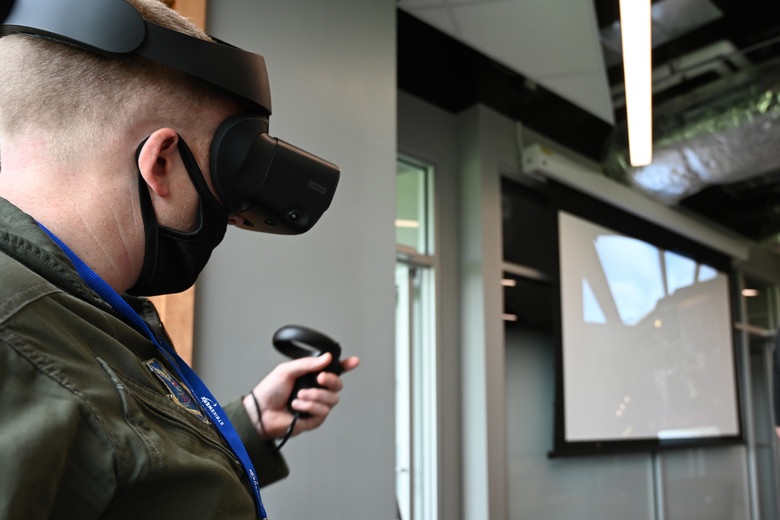
July 16, 2020 – The US Air Force (USAF) has recently announced that a new virtual reality trainer is one step closer to potentially transforming the way B-52 Stratofortress student-pilots train for combat. According to the Air Force, the Virtual Reality Procedures Trainer (VRPT), released during a milestone demonstration of its capabilities on July 7 at StrikeWerx in Bossier City, Louisiana, may even change the entire Air Force bomber community’s approach to training.
The VRPT is the brainchild of Maj. Mark Budgeon, currently assigned to Air Force Global Strike Command, Maj. Brandon Wolf, 307th Operations Support Squadron, and Maj. Justin Stephenson, 11th Bomb Squadron chief pilot and chief of innovations.
“Our adversaries are getting much better, much faster,” Budgeon said. “This system has the potential to revolutionize the entire training process and make our student graduates better.”
The three Airmen teamed up with King Crow Studios, a virtual reality training company and creator of VR game ‘Hive Slayer’, to develop it as part of a larger learning management system that uses virtual reality with an embedded instructor to teach and grade B-52 student pilots.
King Crow Studios have helped to create a 360-degree virtual replica of the cockpit of the B-52 aircraft. Students are able to practice going through the entire ground procedures checklist prior to take-off, entirely in VR.
The main advantages of the VRPT are its potential to reduce human bias in instruction, provide better access to training for student pilots, and give students immediate feedback that lessens the chance they develop poor habits in the early phases of training.
Wolf explained that the current technology used in student pilot training limits hands-on training opportunities. Due to logistical concerns, student pilots don’t have 24-hour access to instructors or training tools. The VRPT has the potential to eliminate that problem, since it employs the use of a computer, plus a VR headset with two controllers to provide students with six degrees of freedom (6DoF) whilst training, meaning students can train almost anywhere in a virtual B-52 cockpit due to the portability of the setup.
“It would be accessible to them all the time, so they can take it home and practice,” Wolf said. “They become familiar with it, and we won’t get that deer-in-headlights moment when they first get in the simulator or B-52.”
Furthermore, the training program also has the capacity to collect data on student performance, with timestamps that show speed and errors. That data can then be used by instructors to provide immediate feedback. “It catches mistakes early on a human might miss so that instructors can create a process for correcting them,” Wolf added. Commenting on the ease of use of the new system, Budgeon added: “Its operating system is intuitive, so all we have to do is hand it to them and say ‘go’,” Budgeon said.
According to the USAF, King Crow Studios is scheduled to produce a complete VRPT prototype later this year. The pilots hope that the trainer moves into the third phase of the contracting process and is ultimately adopted by the 307th Bomb Wing to train all incoming B-52 student pilots for the Air Force. If adopted, the three Airmen stated that they are eager to press forward with similar trainers for the jet’s weapons systems officers and electronic warfare officers.
Cody Louviere, King Crow Studios’ founder, expressed optimism that the three Airmen’s vision for the future will become a reality. “We can do anything in this environment,” Louviere said regarding the training capacity of virtual reality. “We are here at the right time because technology is advancing exponentially.”
For more information on King Crow Studios’ VR training solutions, visit the company’s website.
Image credit: Master Sgt. Ted Daigle / US Air Force
About the author
Sam is the Founder and Managing Editor of Auganix. With a background in research and report writing, he has been covering XR industry news for the past seven years.
